Spatiotemporal Variation and Future Predictions of Soil Salinization in the Werigan–Kuqa River Delta Oasis of China
Abstract
:1. Introduction
2. Materials and Methods
2.1. Study Area
2.2. Electrical Conductivity Data Collection
2.3. Image Data
2.4. Environmental Factors
2.5. Methods
2.5.1. Random Forest
2.5.2. Gradient Boosting Decision Tree
2.5.3. Light Gradient Boosting Machine
2.5.4. EXtreme Gradient Boosting
2.5.5. CA–Markov Model for Predicting Future Soil Salinization
2.5.6. Suitability Atlas Construction and Prediction Process
2.5.7. Trend Analysis Method
2.5.8. Model Validation
2.6. Soil Salinization Classification
3. Results and Discussion
3.1. Accuracy Evaluation
3.2. Spatiotemporal Variation in Soil Salinity
3.3. Transfer Matrix of Soil Salinization
3.4. Interpretation of Prediction Factor Influence on Soil Salinization
3.5. Soil Salinity Predictions for 2020–2050
3.6. Limitations
4. Conclusions
Author Contributions
Funding
Institutional Review Board Statement
Informed Consent Statement
Data Availability Statement
Conflicts of Interest
References
- Khan, N.M.; Rastoskuev, V.V.; Shalina, E.V.; Sato, Y. Mapping salt-affected soils using remote sensing indicators—A simple approach with the use of GIS IDRISI. In Proceedings of the 22nd Asian Conference on Remote Sensing, Singapore, 5–9 November 2001. [Google Scholar]
- Moreau, S.S. Application of remote sensing and GIS to the mapping of saline\sodic soils and evaluation of codification risks in the Province of Villarreal, central Altiplano, Bolivia. In Proceedings of the 4th International Symposium on High Mountain Remote Sensing Cartography, Berlin, Germany, 22–26 July 1996; pp. 19–29. [Google Scholar]
- Dwivedi, R.S.; Sreenivas, K. Image transforms as a tool for the study of soil salinity and alkalinity dynamics. Int. J. Remote Sens. 1998, 19, 605–619. [Google Scholar] [CrossRef]
- Zhang, T.-T.; Qi, J.-G.; Gao, Y.; Ouyang, Z.-T.; Zeng, S.-L.; Zhao, B. Detecting soil salinity with MODIS time series VI data. Ecol. Indic. 2015, 52, 480–489. [Google Scholar] [CrossRef]
- Singh, A. Soil salinization management for sustainable development: A review. J. Environ. Manag. 2020, 277, 111383. [Google Scholar] [CrossRef] [PubMed]
- McBratney, A.B.; Santos, M.M.; Minasny, B. On digital soil mapping. Geoderma 2003, 117, 3–52. [Google Scholar] [CrossRef]
- Minasny, B.; McBratney, A. Digital soil mapping: A brief history and some lessons. Geoderma 2016, 264, 301–311. [Google Scholar] [CrossRef]
- Beguin, J.; Fuglstad, G.-A.; Mansuy, N.; Paré, D. Predicting soil properties in the Canadian boreal forest with limited data: Comparison of spatial and non-spatial statistical approaches. Geoderma 2017, 306, 195–205. [Google Scholar] [CrossRef]
- Padarian, J.; Minasny, B.; McBratney, A.B. Machine learning and soil sciences: A review aided by machine learning tools. SOIL 2020, 6, 35–52. [Google Scholar] [CrossRef]
- Taghizadeh-Mehrjardi, R.; Schmidt, K.; Toomanian, N.; Heung, B.; Behrens, T.; Mosavi, A.; Band, S.S.; Amirian-Chakan, A.; Fathabadi, A.; Scholten, T. Improving the spatial prediction of soil salinity in arid regions using wavelet transformation and support vector regression models. Geoderma 2021, 383, 114793. [Google Scholar] [CrossRef]
- Lui, T.C.; Gregory, D.D.; Anderson, M.; Lee, W.-S.; Cowling, S.A. Applying machine learning methods to predict geology using soil sample geochemistry. Appl. Comput. Geosci. 2022, 16, 100094. [Google Scholar] [CrossRef]
- Liu, J.; Yang, K.; Tariq, A.; Lu, L.; Soufan, W.; El Sabagh, A. Interaction of climate, topography and soil properties with cropland and cropping pattern using remote sensing data and machine learning methods. Egypt. J. Remote Sens. Space Sci. 2023, 26, 415–426. [Google Scholar] [CrossRef]
- Gorji, T.; Sertel, E.; Tanik, A. Monitoring soil salinity via remote sensing technology under data scarce conditions: A case study from Turkey. Ecol. Indic. 2017, 74, 384–391. [Google Scholar] [CrossRef]
- Allbed, A.; Kumar, L. Soil salinity mapping and monitoring in arid and semi-arid regions using remote sensing technology: A review. Adv. Remote Sens. 2013, 2, 373–385. [Google Scholar] [CrossRef]
- Metternicht, G.I.; Zinck, J.A. Remote sensing of soil salinity: Potentials and constraints. Remote Sens. Environ. 2003, 85, 1–20. [Google Scholar] [CrossRef]
- Qiao, M.; Zhou, S.; Lu, L.; Yan, J.; Song, P.; Xu, W. Causes and spatial-temporal changes of soil salinization in Weigan River Basin, Xinjiang. Prog. Geogr. 2012, 31, 904–910. [Google Scholar]
- Bian, L.; Wang, J.; Liu, J.; Han, B. Spatiotemporal Changes of Soil Salinization in the Yellow River Delta of China from 2015 to 2019. Sustainability 2021, 13, 822. [Google Scholar] [CrossRef]
- Alnaimy, M.A.; Elrys, A.S.; Zelenakova, M.; Pietrucha-Urbanik, K.; Merwad, A.-R.M. The Vital Roles of Parent Material in Driving Soil Substrates and Heavy Metals Availability in Arid Alkaline Regions: A Case Study from Egypt. Water 2023, 15, 2481. [Google Scholar] [CrossRef]
- Yin, X.; Feng, Q.; Li, Y.; Deo, R.; Liu, W.; Zhu, M.; Zheng, X.; Liu, R. An interplay of soil salinization and groundwater deg-radation threatening coexistence of oasis-desert ecosystems. Sci. Total Environ. 2022, 806, 150599. [Google Scholar] [CrossRef]
- Li, Y.; Wang, C.; Wright, A.; Liu, H.; Zhang, H.; Zong, Y. Combination of GF-2 high spatial resolution imagery and land surface factors for predicting soil salinity of muddy coasts. Catena 2021, 202, 105304. [Google Scholar] [CrossRef]
- Corwin, D.L. Climate change impacts on soil salinity in agricultural areas. Eur. J. Soil Sci. 2021, 72, 842–862. [Google Scholar] [CrossRef]
- Schofield, R.V.; Kirkby, M.J. Application of salinization indicators and initial development of potential global soil salinization scenario under climatic change. Glob. Biogeochem. Cycles 2003, 17. [Google Scholar] [CrossRef]
- Hassani, A.; Azapagic, A.; Shokri, N. Global predictions of primary soil salinization under changing climate in the 21st century. Nat. Commun. 2021, 12, 6663. [Google Scholar] [CrossRef] [PubMed]
- Zhang, Y.; Chang, X.; Liu, Y.; Lu, Y.; Wang, Y.; Liu, Y. Urban expansion simulation under constraint of multiple ecosystem services (MESs) based on cellular automata (CA)-Markov model: Scenario analysis and policy implications. Land Use Policy 2021, 108, 105667. [Google Scholar] [CrossRef]
- Fu, F.; Deng, S.; Wu, D.; Liu, W.; Bai, Z. Research on the spatiotemporal evolution of land use landscape pattern in a county area based on CA-Markov model. Sustain. Cities Soc. 2022, 80, 103760. [Google Scholar] [CrossRef]
- Wang, L.; Hu, P.; Zheng, H.; Liu, Y.; Cao, X.; Hellwich, O.; Liu, T.; Luo, G.; Bao, A.; Chen, X. Integrative modeling of heterogeneous soil salinity using sparse ground samples and remote sensing images. Geoderma 2023, 430, 116321. [Google Scholar] [CrossRef]
- Li, X.; Yang, J.; Liu, M.; Liu, G.; Mei, Y. Spatio-temporal changes of soil salinity in arid areas of south Xinjiang using electromagnetic induction. J. Integr. Agric. 2012, 11, 1365–1376. [Google Scholar] [CrossRef]
- Gorelick, N.; Hancher, M.; Dixon, M.; Ilyushchenko, S.; Thau, D.; Moore, R. Google Earth Engine: Planetary-scale geospatial analysis for everyone. Remote Sens. Environ. 2017, 202, 18–27. [Google Scholar] [CrossRef]
- Wang, F.; Yang, S.; Wei, Y.; Shi, Q.; Ding, J. Characterizing soil salinity at multiple depth using electromagnetic induction and remote sensing data with random forests: A case study in Tarim River Basin of southern Xinjiang, China. Sci. Total Environ. 2021, 754, 142030. [Google Scholar] [CrossRef] [PubMed]
- Taghizadeh-Mehrjardi, R.; Minasny, B.; Sarmadian, F.; Malone, B. Digital mapping of soil salinity in Ardakan region, central Iran. Geoderma 2014, 213, 15–28. [Google Scholar] [CrossRef]
- Sandholt, I.; Rasmussen, K.; Andersen, J. A simple interpretation of the surface temperature/vegetation index space for assessment of surface moisture status. Remote Sens. Environ. 2002, 79, 213–224. [Google Scholar] [CrossRef]
- Wang, F.; Ding, J.; Wei, Y.; Zhou, Q.; Yang, X.; Wang, Q. Sensitivity analysis of soil salinity and Vegetation indices to detect soil salinity variation by using Landsat series images: Application in different oases in Xinjiang, China. Acta Ecol. 2017, 37, 5007–5022. [Google Scholar]
- Batjes, N.H.; Ribeiro, E.; van Oostrum, A. Standardised soil profile data to support global mapping and modelling (WoSIS snapshot 2019). Earth Syst. Sci. Data 2020, 12, 299–320. [Google Scholar] [CrossRef]
- Cheng, X.; Zhou, Z.; Li, W.; Shangguan, D.; Wang, X.; Zhang, X.; Hao, J.; Lin, Q. Monitoring drought situation and analyzing influencing factors in Central Asia using MODIS data. Trans. Chin. Soc. Agric. Eng. (Trans. CSAE) 2022, 38, 128–137. [Google Scholar]
- He, B.; Ding, J.; Liu, B.; Wang, J. Spatiotemporal variation of soil salinization in Weigan-Kuqa River Delta Oasis. Sci. Silvae Sin. 2019, 55, 185–196. [Google Scholar]
- Krishnan, S.; Indu, J. Assessing the potential of temperature/vegetation index space to infer soil moisture over Ganga Basin. J. Hydrol. 2023, 621, 129611. [Google Scholar] [CrossRef]
- Li, Y.; Chang, C.; Wang, Z.; Zhao, G. Remote sensing prediction and characteristic analysis of cultivated land salinization in different seasons and multiple soil layers in the coastal area. Int. J. Appl. Earth Obs. Geoinf. 2022, 111, 102838. [Google Scholar] [CrossRef]
- Guo, X.; Gui, X.; Xiong, H.; Hu, X.; Li, Y.; Cui, H.; Qiu, Y.; Ma, C. Critical role of climate factors for groundwater potential mapping in arid regions: Insights from random forest, XGBoost, and LightGBM algorithms. J. Hydrol. 2023, 621, 129599. [Google Scholar] [CrossRef]
- Kaplan, G.; Gašparović, M.; Alqasemi, A.S.; Aldhaheri, A.; Abuelgasim, A.; Ibrahim, M. Soil salinity prediction using Machine Learning and Sentinel-2 Remote Sensing Data in Hyper-Arid areas. Phys. Chem. Earth Parts A/B/C 2023, 130, 103400. [Google Scholar] [CrossRef]
- He, Y.; Zhang, Z.; Xiang, R.; Ding, B.; Du, R.; Yin, H.; Chen, Y.; Ba, Y. Monitoring salinity in bare soil based on Sentinel-1/2 image fusion and machine learning. Infrared Phys. Technol. 2023, 131, 104656. [Google Scholar] [CrossRef]
- Fathizad, H.; Ardakani, M.A.H.; Sodaiezadeh, H.; Kerry, R.; Taghizadeh-Mehrjardi, R. Investigation of the spatial and temporal variation of soil salinity using random forests in the central desert of Iran. Geoderma 2020, 365, 114233. [Google Scholar] [CrossRef]
- Das, A.; Bhattacharya, B.K.; Setia, R.; Jayasree, G.; Das, B.S. A novel method for detecting soil salinity using AVIRIS-NG imaging spectroscopy and ensemble machine learning. ISPRS J. Photogramm. Remote Sens. 2023, 200, 191–212. [Google Scholar] [CrossRef]
- Tariq, A.; Yan, J.; Mumtaz, F. Land change modeler and CA-Markov chain analysis for land use land cover change using satellite data of Peshawar, Pakistan. Phys. Chem. Earth Parts A/B/C 2022, 128, 103286. [Google Scholar] [CrossRef]
- Heung, B.; Ho, H.C.; Zhang, J.; Knudby, A.; Bulmer, C.E.; Schmidt, M.G. An overview and comparison of machine-learning techniques for classification purposes in digital soil mapping. Geoderma 2016, 265, 62–77. [Google Scholar] [CrossRef]
- Hong, Y.; Shen, R.; Cheng, H.; Chen, Y.; Zhang, Y.; Liu, Y.; Zhou, M.; Yu, L.; Liu, Y.; Liu, Y. Estimating lead and zinc concentrations in peri-urban agricultural soils through reflectance spectroscopy: Effects of fractional-order derivative and random forest. Sci. Total Environ. 2018, 651 Pt 2, 1969–1982. [Google Scholar] [CrossRef]
- Dewage, S.N.S.P.; Minasny, B.; Malone, B. Disaggregating a regional-extent digital soil map using Bayesian area-to-point regression kriging for farm-scale soil carbon assessment. SOIL 2020, 6, 359–369. [Google Scholar] [CrossRef]
- Kursa, M.B.; Rudnicki, W.R. Feature Selection with the Boruta Package. J. Stat. Softw. 2010, 36, 1–13. [Google Scholar] [CrossRef]
- Friedman, J.H. Greedy function approximation: A gradient boosting machine. Ann. Stat. 2001, 29, 1189–1232. [Google Scholar] [CrossRef]
- Meng, R. Research on Water Depth Inversion Method Based on Remote Sensing Image. Master’s Thesis, Shanghai Ocean University, Shanghai, China, 2022. [Google Scholar]
- Ke, R.; Wu, S.; Ke, W. A spatial-temporal model for identifying tidal shared-bicycle stops and bicycle sharing demand pre-diction based on KNN-LightGBM. J. Geoinf. Sci. 2023, 25, 741–753. [Google Scholar]
- Ke, G.; Meng, Q.; Finley, T.; Wang, T.; Chen, W.; Ma, W.; Ye, Q.; Liu, T. LightGBM: A highly efficient gradient boosting decision tree. Adv. Neural Inf. Process. Syst. 2017, 30. [Google Scholar]
- Xiao, C.; Ji, Q.; Chen, J.; Zhang, F.; Li, Y.; Fan, J.; Hou, X.; Yan, F.; Wang, H. Prediction of soil salinity parameters using machine learning models in an arid region of Northwest China. Comput. Electron. Agric. 2023, 204, 107512. [Google Scholar] [CrossRef]
- Chen, T.; Guestrin, C. XGBoost: A scalable tree boosting system. In Proceedings of the KDD ’16: The 22nd ACM SIGKDD International Conference on Knowledge Discovery and Data Mining, San Francisco, CA, USA, 13–17 August 2016; pp. 785–794. [Google Scholar]
- Li, Y.; Peng, D.; Yuan, Y. Airborne LiDAR data inversion of forest aboveground biomass using XGBoost algorithm. J. Northeast. For. Univ. 2023, 51, 106–112. [Google Scholar]
- Huang, Z.; Shen, J.; Jian, W.; Fan, X.; Nie, W. Displacement prediction of rainfall-induced step-like landslide based on XGBoost model. J. Nat. Disasters 2023, 32, 217–226. [Google Scholar]
- Yang, G.; Liu, Y.; Wu, Z. Analysis and simulation of land-use temporal and spatial pattern based on CA-Markov model. Geomat. Inf. Sci. Wuhan Univ. 2007, 32, 414–418. [Google Scholar]
- Yang, J.; Xie, P.; Xi, J.; Ge, Q.; Li, X.; Ma, Z. LUCC simulation based on the cellular automata simulation: A case study of Dalian Economic and Technological Development Zone. Acta Geogr. Sin. 2015, 70, 461–475. [Google Scholar]
- Qian, Y.; Xing, W.; Guan, X.; Yang, T.; Wu, H. Coupling cellular automata with area partitioning and spatiotemporal convolution for dynamic land use change simulation. Sci. Total Environ. 2020, 722, 137738. [Google Scholar] [CrossRef]
- Gao, X.; Yang, L.; Li, C.; Song, Z.; Wang, J. Land use change and ecosystem service value measurement in Baiyangdian Basin under the simulated multiple scenarios. Acta Ecol. Sin. 2021, 41, 7974–7988. [Google Scholar]
- He, Y.; Fan, G.; Zhang, X.; Li, Z.; Gao, D. Vegetation phenological variation and its response to climate changes in Zhejiang province. J. Nat. Resour. 2013, 28, 220–233. [Google Scholar]
- Tursun, H.; Turangul, H. soil salinization types in typical oasis in Northern Taklamakan Basin. Heilongjiang Agric. Sci. 2017, 4, 24–30. [Google Scholar]
- Qiao, M.; Zhou, S.; Lu, L.; Yan, J.; Li, H. Temporal and spatial changes of soil salinization and improved countermeasures of Tarim Basin Irrigation District in recent 25 a. Arid. Land Geogr. 2011, 34, 604–613. [Google Scholar]
- Qiao, M.; Tian, C.; Wang, X. Soil Salinization and Its Improvement and Control Model in Irrigation Areas of Xinjiang; Xinjiang Science and Technology Publishing House: Urumqi, China, 2008; pp. 1–25. [Google Scholar]
- Jiao, R.; Bu, D.; Zhang, T.; Shao, Y.; Chen, L.; Shui, Y. Evaluation of soil nutrient status in Alar cotton planting area of Xinjiang. J. Shihezi Univ. 2023, 41, 160–167. [Google Scholar]
- Zhao, Z.; Zhang, H.; Huang, J.; Li, F.; Yu, Q. Dynamic change of water and salt and their coupling relationships in Weigan River Irrigation District. J. Arid. Land Resour. Environ. 2008, 22, 142–146. [Google Scholar]
- Wang, X.; Gao, Q.; Lu, Q.; Li, B. Salt-water balance and dry drainage desalting in Hetao irrigating area, Inner Mongolia. Sci. Geogr. Sin. 2006, 26, 455–460. [Google Scholar]
- Zhang, X.; Yang, D.; Liu, Y. Emergy-based sustainability and sensitivity analysis of oasis cropping system: A case study in Weigan River Basin. Acta Ecol. Sin. 2009, 29, 6068–6076. [Google Scholar]
- Akramkhanov, A.; Martius, C.; Park, S.; Hendrickx, J. Environmental factors of spatial distribution of soil salinity on flat irrigated terrain. Geoderma 2011, 163, 55–62. [Google Scholar] [CrossRef]
- Moore, I.D.; Grayson, R.B.; Ladson, A.R. Digital terrain modelling: A review of hydrological, geomorphological, and biological applications. Hydrol. Process 1991, 5, 3–30. [Google Scholar] [CrossRef]
- Jafari, A.; Finke, P.A.; Wauw, J.V.; Ayoubi, S.; Khademi, H. Spatial prediction of USDA- great soil groups in the arid Zarand region, Iran: Comparing logistic regression approaches to predict diagnostic horizons and soil types. Eur. J. Soil Sci. 2012, 63, 284–298. [Google Scholar] [CrossRef]
- Ge, X.; Ding, J.; Teng, D.; Wang, J.; Huo, T.; Jin, X.; Wang, J.; He, B.; Han, L. Updated soil salinity with fine spatial resolution and high accuracy: The synergy of Sentinel-2 MSI, environmental covariates and hybrid machine learning approaches. CATENA 2022, 212, 106054. [Google Scholar] [CrossRef]
- Liu, X.; Liang, X.; Li, X.; Xu, X.; Ou, J.; Chen, Y.; Li, S.; Wang, S.; Pei, F. A future land use simulation model (FLUS) for simulating multiple land use scenarios by coupling human and natural effects. Landsc. Urban Plan. 2017, 168, 94–116. [Google Scholar] [CrossRef]
- Chen, H.; Gao, Y.; Dang, X. Prediction of land use change in Kubuqi Desert based on CA—Markov model. J. Inn. Mong. For. Sci. Technol. 2022, 48, 18–22+34. [Google Scholar]
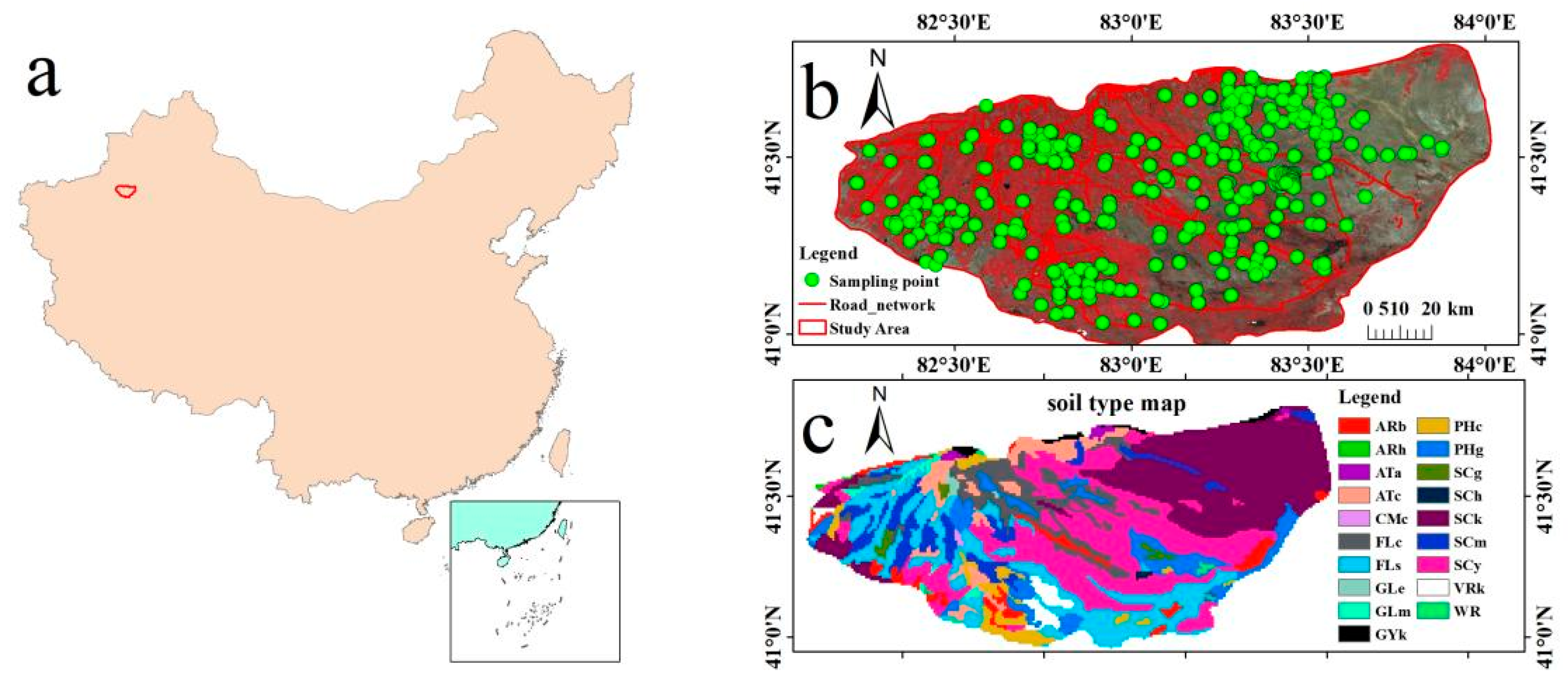
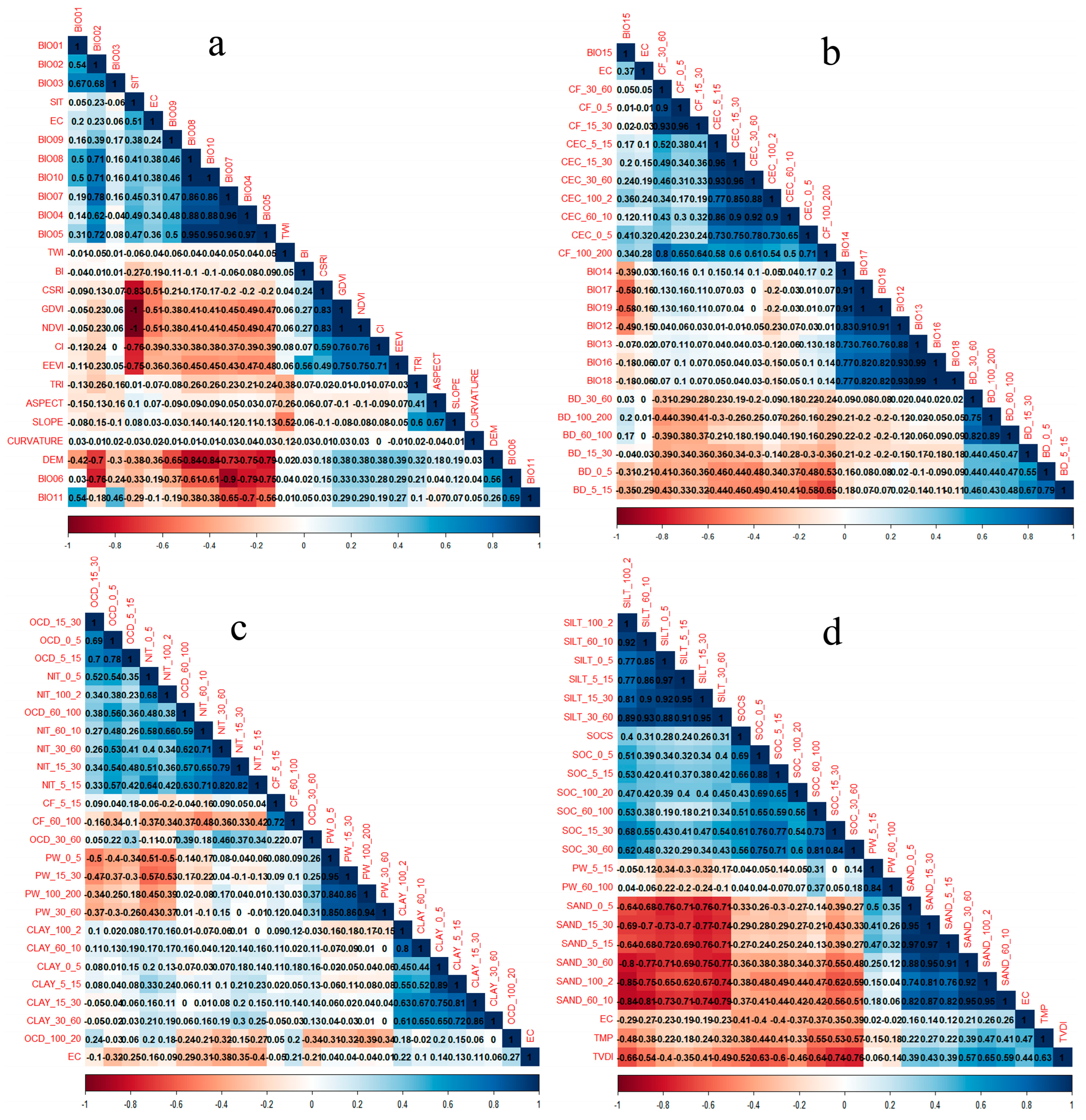
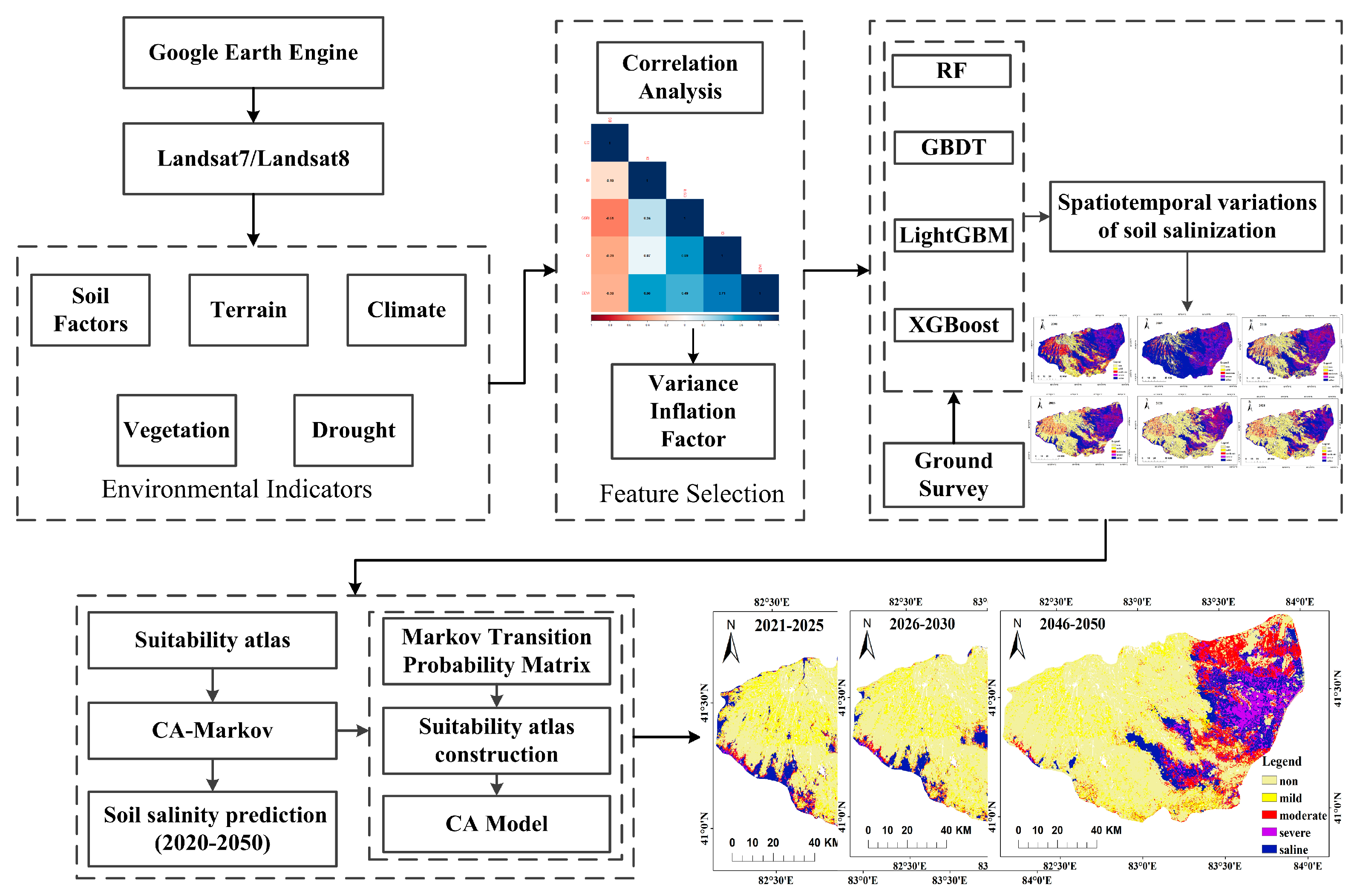
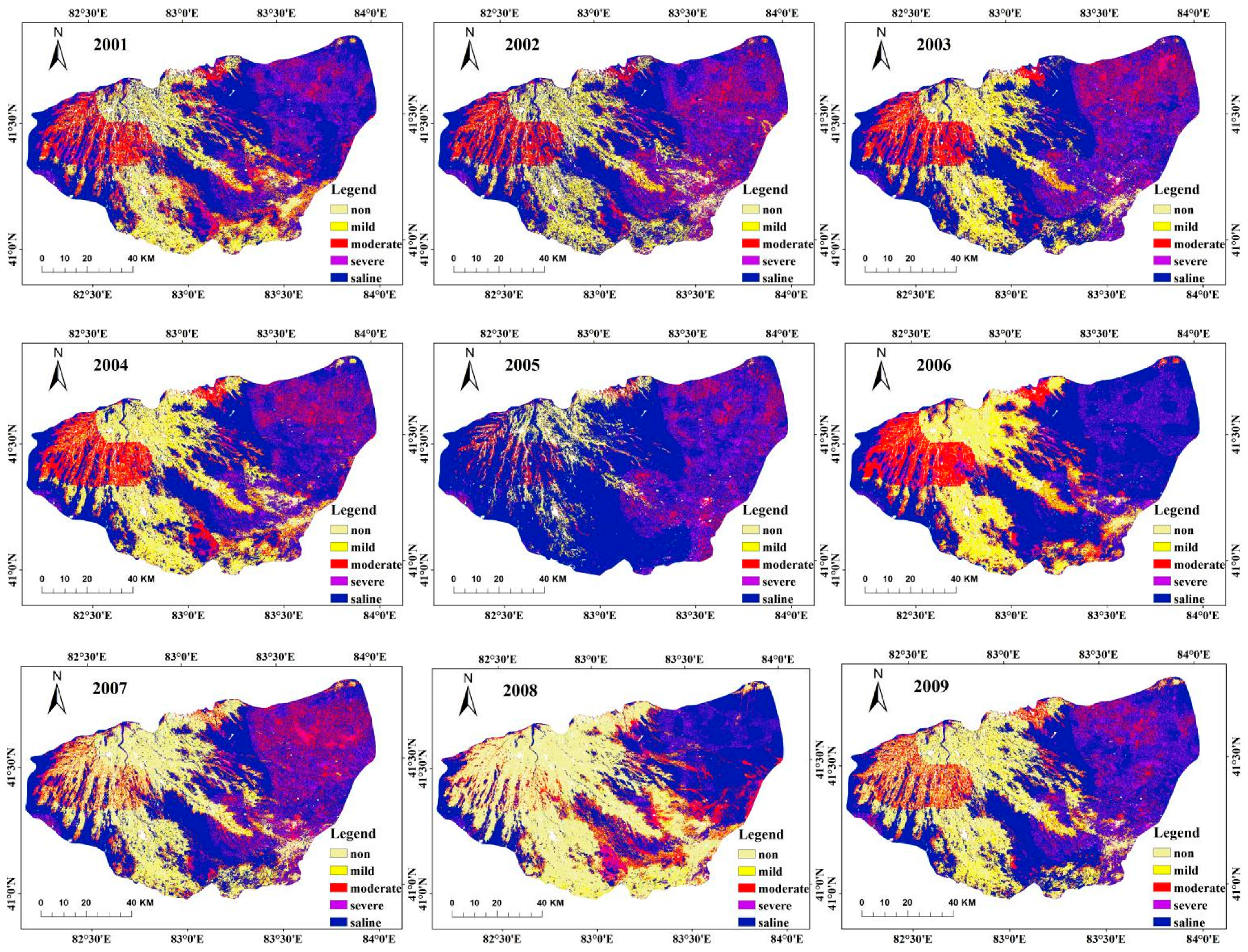
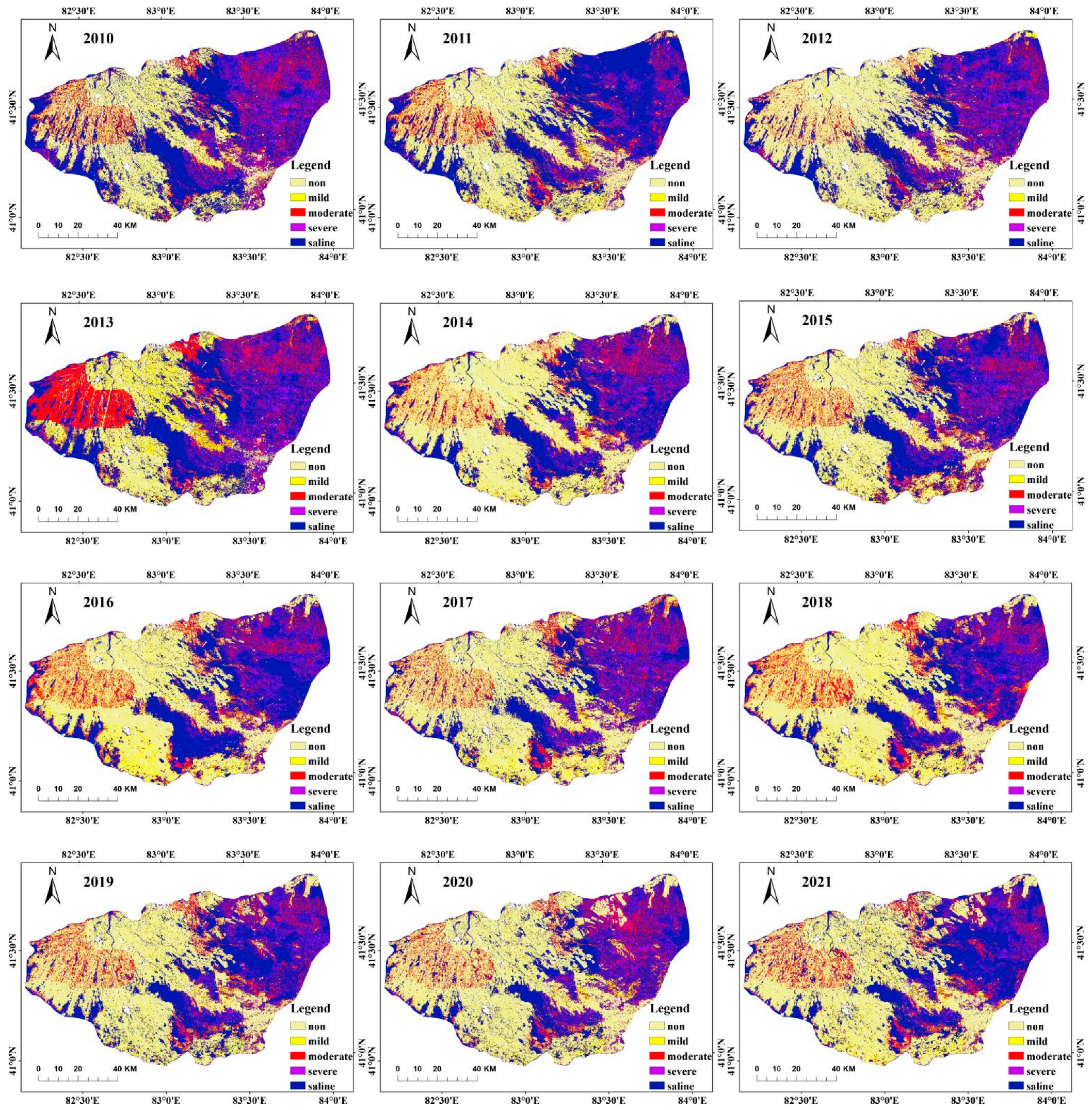
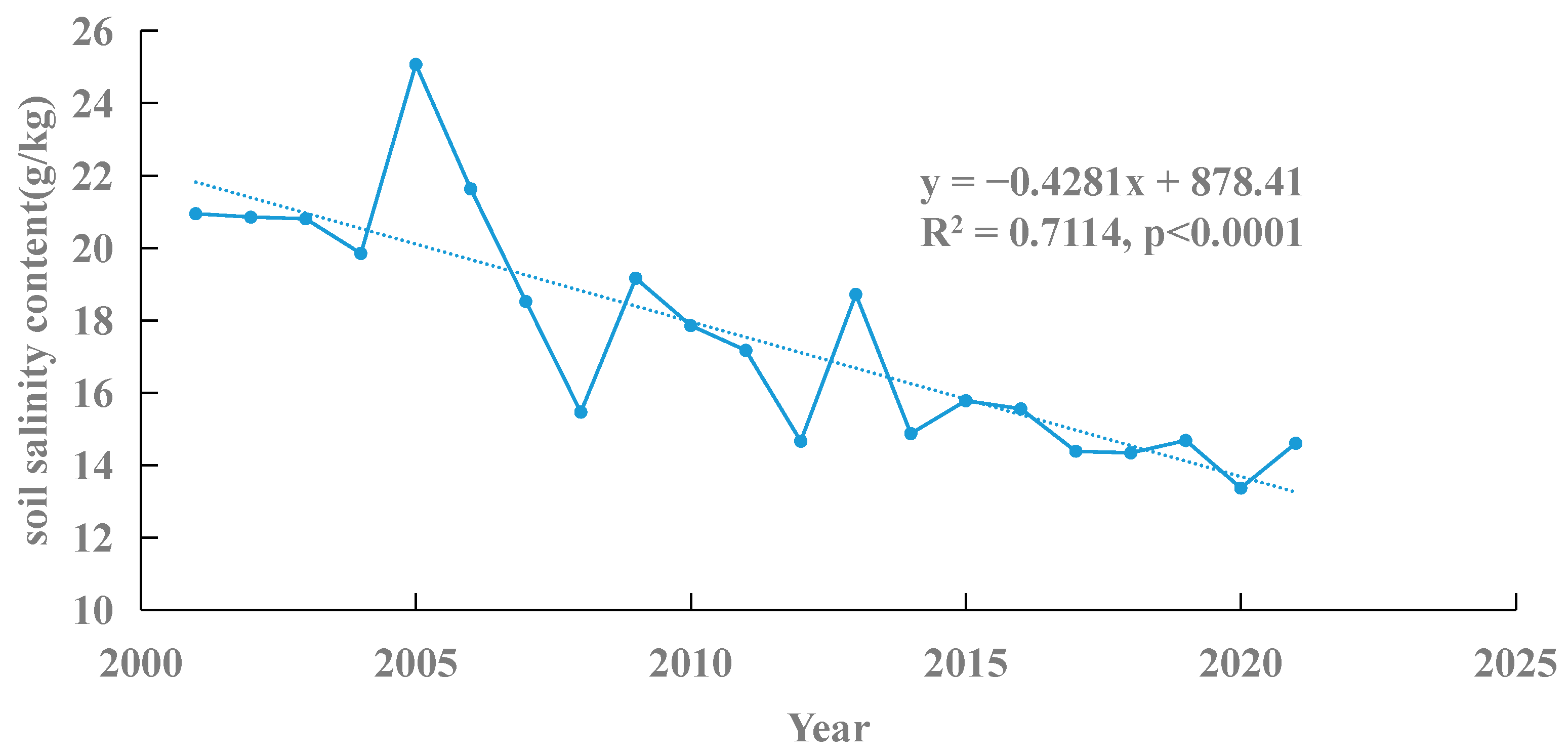
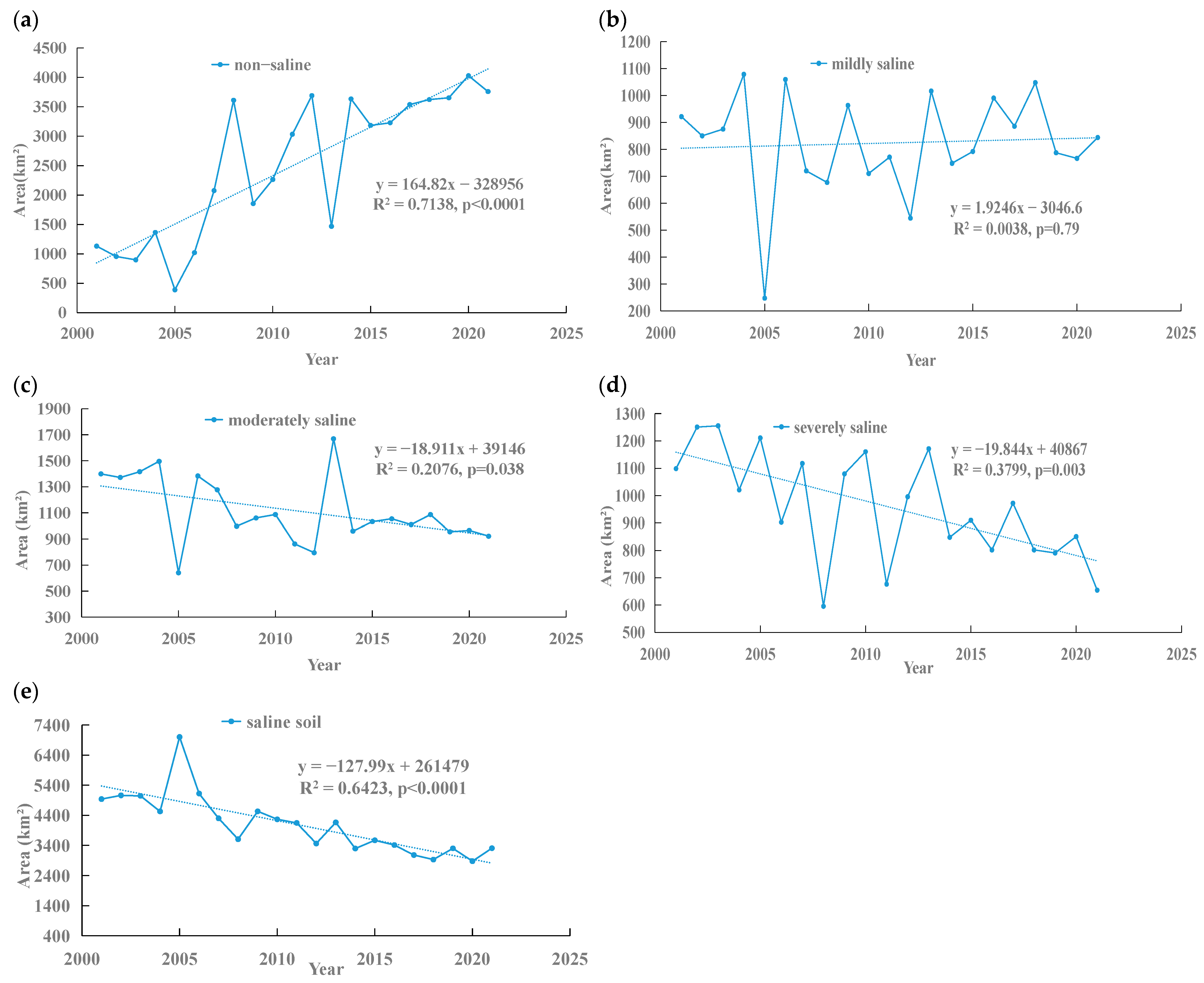
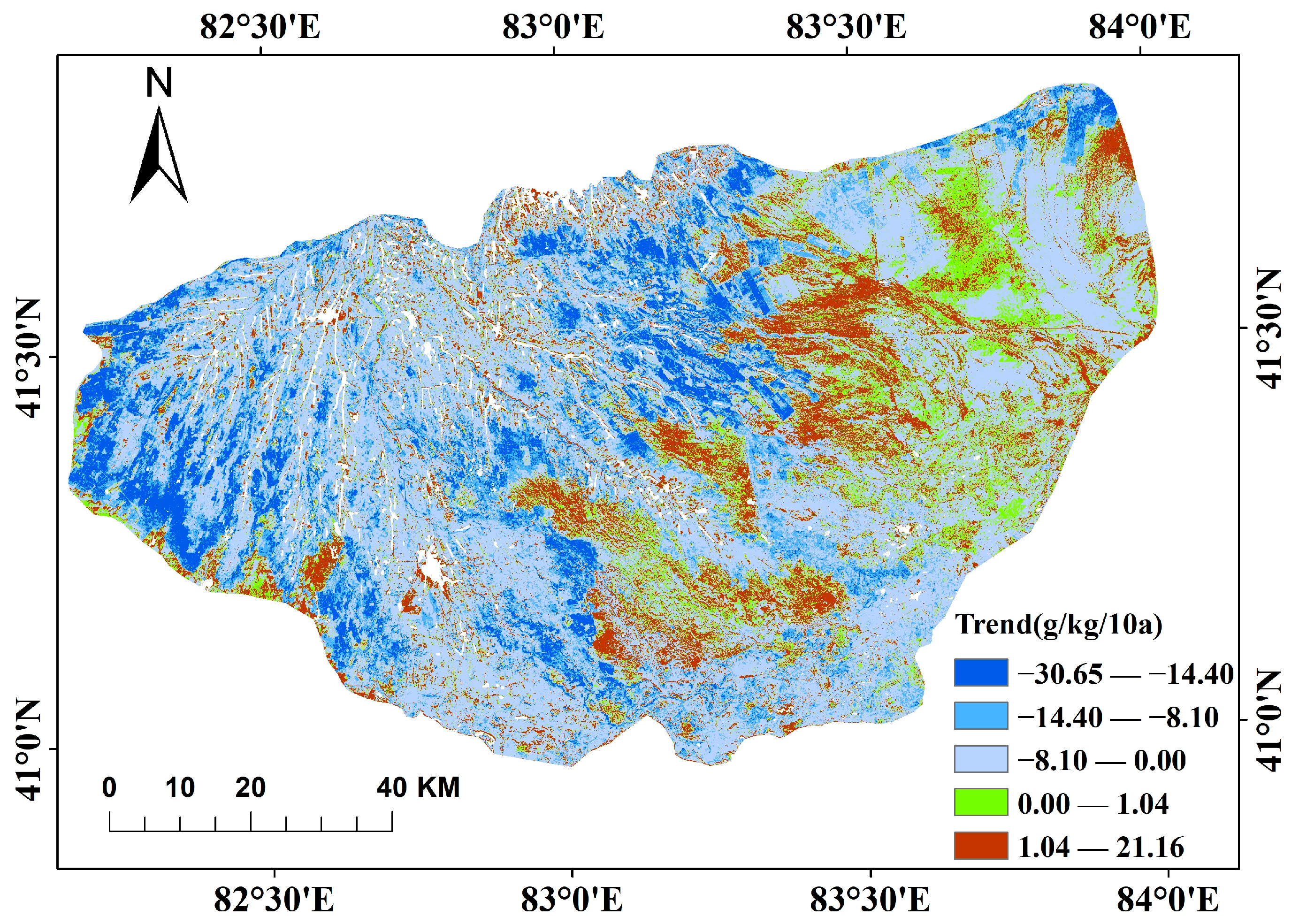
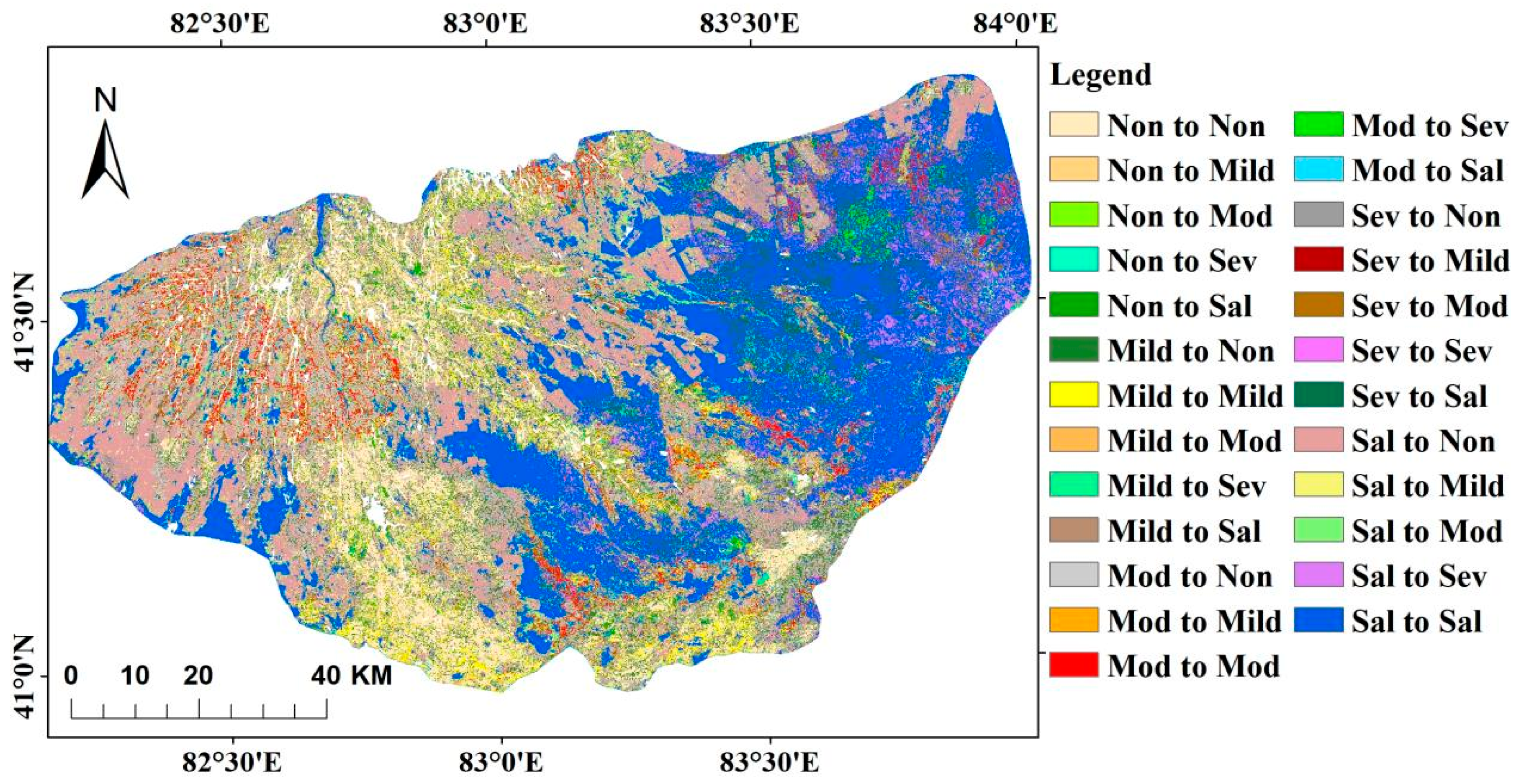

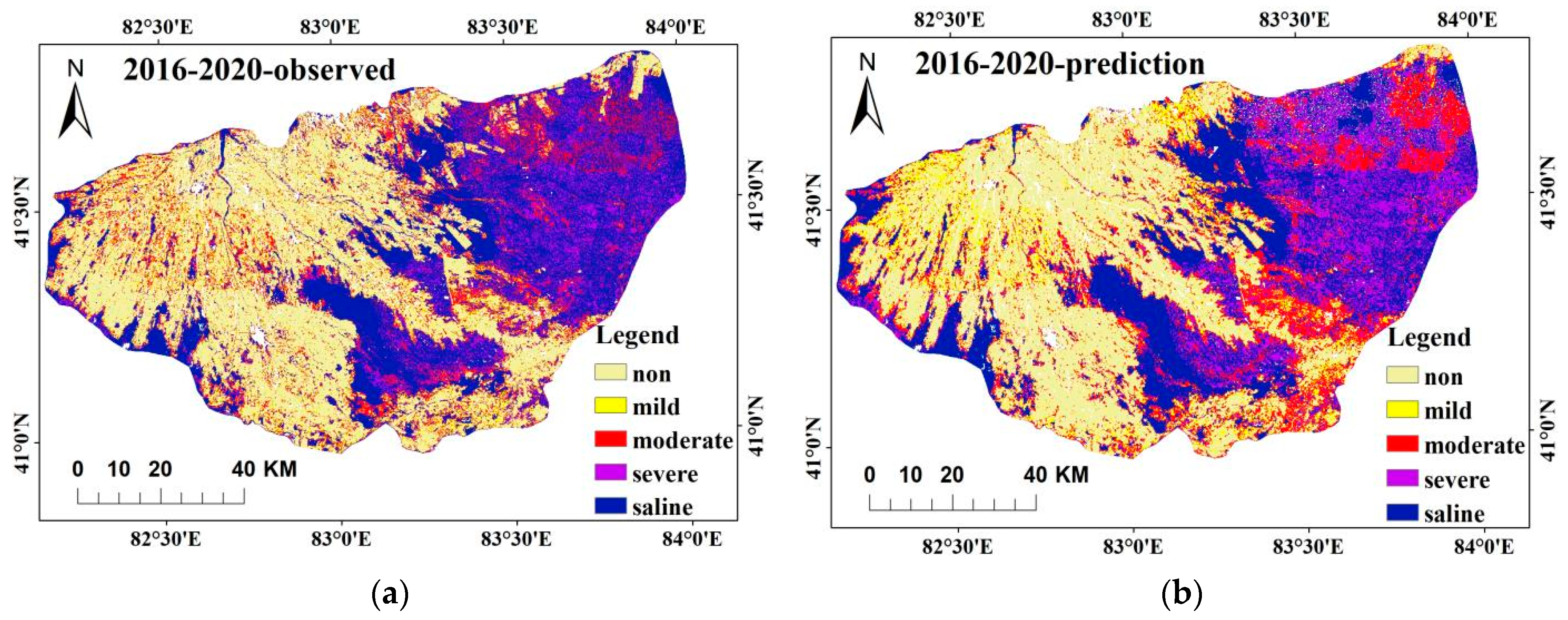
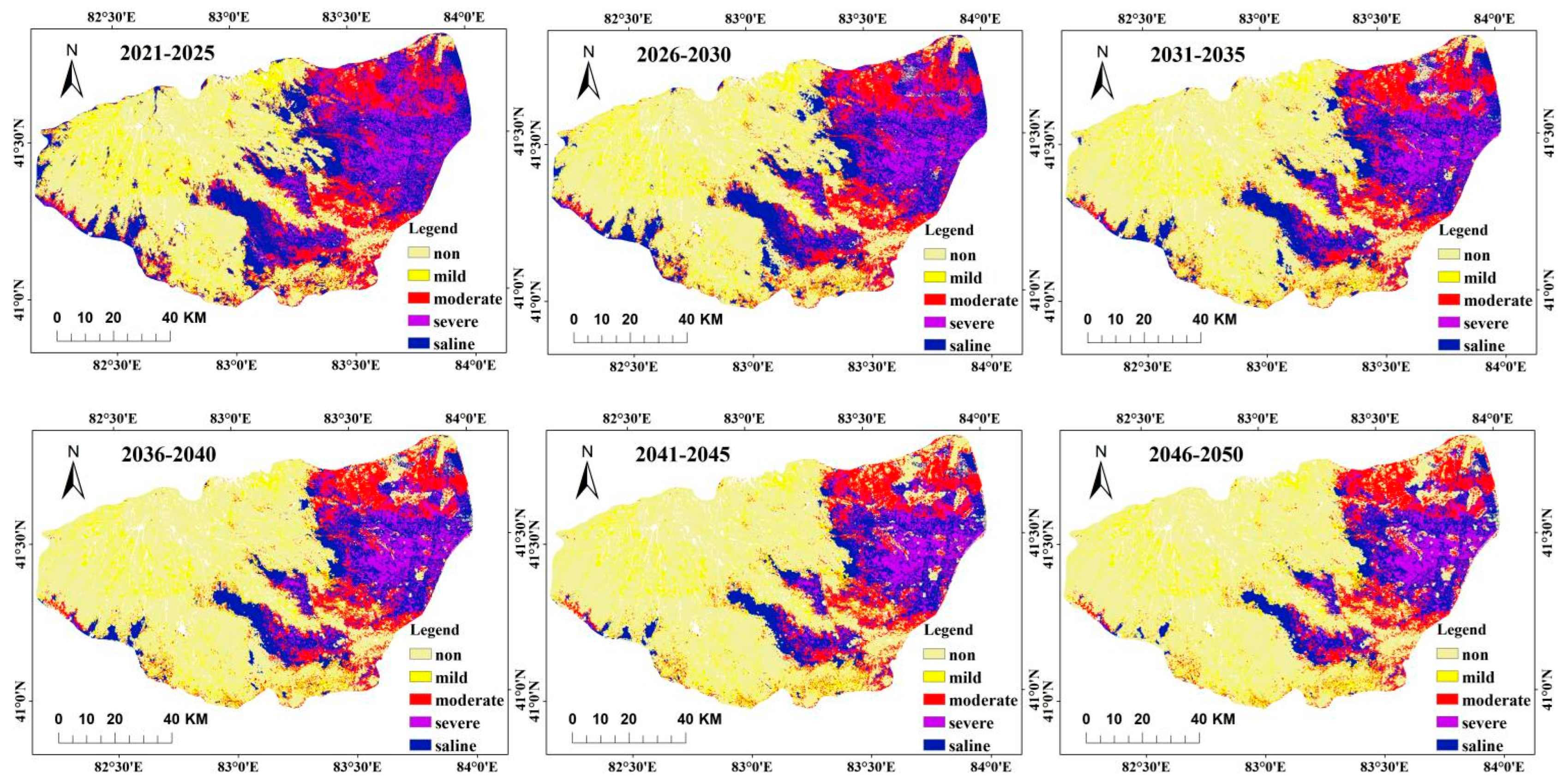
| Auxiliary Data | Environmental Covariates and Abbreviations | Original Resolution and Expression | Source | Reference |
|---|---|---|---|---|
| Terrain attributes | Digital elevation model (DEM) | 30 m | ASTER GDEM NASA | 2 |
| Slope | 30 m | SAGA GIS | 2 | |
| Aspect | 30 m | SAGA GIS | 2 | |
| Topographic wetness index (TWI) | 30 m 30 m | SAGA GIS | 2 | |
| Topographic relief index (TRI) | 30 m | SAGA GIS | 2 | |
| Soil properties | Clay content (Clay) | 250 m 1 | SAGA GIS | 3 |
| Soil organic carbon (SOC) | 250 m | SAGA GIS | 3 | |
| Bulk density (BD) | 250 m | SAGA GIS | 3 | |
| Cation exchange capacity (CEC) | 250 m | SAGA GIS | 3 | |
| Sand content (Sand) | 250 m | SAGA GIS | 3 | |
| Silt content (Silt) | 250 m | SAGA GIS | 3 | |
| Coarse fragments (CFs) | 250 m | SAGA GIS | 3 | |
| Nitrogen (Nit) | 250 m | SAGA GIS | 3 | |
| Organic carbon density (OCD) | 250 m | SAGA GIS | 3 | |
| pH water (PW) | 250 m | SAGA GIS | 3 | |
| Soil organic carbon stock (SOCS) | 250 m | SAGA GIS | 3 | |
| Climate | Precipitation (PRE) | 25 km | TRMM 3B43 | 3 |
| Temperature (TMP) | 1 km | MOD11A2 NASA | 3 | |
| Bioclimatic variables (Bio 1, Bio 2, Bio 3, … Bio 19) | 1 km | www.worldclim.org accessed on 19 September 2023 | 4 | |
| Salinity index | SI-T (Salinity index) | 30 m × 100 | Landsat5/7/8 | 4 |
| BI (Brightness index) | ditto | Landsat5/7/8 | 4 | |
| Vegetation index | NDVI (Normalized differential vegetation index) | ditto | Landsat5/7/8 | 4 |
| EVI (Enhanced vegetation index) | ditto | Landsat5/7/8 | 4 | |
| GDVI (Generalized difference vegetation index) | ditto | Landsat5/7/8 | 4 | |
| CRSI (Canopy response salinity index) | ditto | Landsat5/7/8 | 4 | |
| Drought Index | TVDI (Temperature vegetation drought index) | ditto Tmax = a + b × NDVI Tmin = c + d × NDVI a, b, c, and d are the fitting coefficients of the dry and wet line | Landsat5/7/8 | 5 |
| Algorithm | MAE (dS m−1) | RMSE (dS m−1) | R2 | RPIQ |
|---|---|---|---|---|
| RF | 9.23 | 12.84 | 0.68 | 2.86 |
| XGBoost | 8.77 | 12.30 | 0.71 | 2.98 |
| GBDT | 8.43 | 12.15 | 0.72 | 3.02 |
| LightGBM | 9.20 | 11.88 | 0.73 | 3.08 |
| Year | Non | Proportion (%) | Mild | Proportion (%) | Moderate | Proportion (%) | Severe | Proportion (%) | Saline Soil | Proportion (%) |
|---|---|---|---|---|---|---|---|---|---|---|
| 2001 | 1131.08 | 11.92 | 921.69 | 9.71 | 1399.18 | 14.74 | 1098.56 | 11.58 | 4939.35 | 52.05 |
| 2002 | 954.83 | 10.06 | 850.29 | 8.96 | 1371.61 | 14.45 | 1250.80 | 13.18 | 5062.32 | 53.34 |
| 2003 | 897.37 | 9.46 | 874.99 | 9.22 | 1416.00 | 14.92 | 1255.27 | 13.23 | 5046.22 | 53.17 |
| 2004 | 1363.80 | 14.37 | 1078.87 | 11.37 | 1496.00 | 15.76 | 1020.53 | 10.75 | 4530.65 | 47.74 |
| 2005 | 388.09 | 4.09 | 247.31 | 2.61 | 641.36 | 6.76 | 1211.02 | 12.76 | 7002.08 | 73.78 |
| 2006 | 1020.62 | 10.75 | 1059.37 | 11.16 | 1383.15 | 14.58 | 902.30 | 9.51 | 5124.41 | 54.00 |
| 2007 | 2074.65 | 21.86 | 720.06 | 7.59 | 1277.27 | 13.46 | 1117.33 | 11.77 | 4300.54 | 45.32 |
| 2008 | 3611.34 | 38.05 | 677.09 | 7.13 | 998.06 | 10.52 | 595.75 | 6.28 | 3607.62 | 38.02 |
| 2009 | 1854.19 | 19.54 | 963.20 | 10.15 | 1060.48 | 11.17 | 1079.45 | 11.37 | 4532.53 | 47.76 |
| 2010 | 2264.21 | 23.86 | 710.27 | 7.48 | 1087.28 | 11.46 | 1160.39 | 12.23 | 4267.71 | 44.97 |
| 2011 | 3032.65 | 31.96 | 771.00 | 8.12 | 862.35 | 9.09 | 676.52 | 7.13 | 4147.33 | 43.70 |
| 2012 | 3690.54 | 38.89 | 544.62 | 5.74 | 795.26 | 8.38 | 995.56 | 10.49 | 3463.88 | 36.50 |
| 2013 | 1467.16 | 15.46 | 1016.68 | 10.71 | 1669.36 | 17.59 | 1171.24 | 12.34 | 4165.42 | 43.89 |
| 2014 | 3633.70 | 38.29 | 748.35 | 7.89 | 961.02 | 10.13 | 848.17 | 8.94 | 3298.62 | 34.76 |
| 2015 | 3183.97 | 33.55 | 792.19 | 8.35 | 1032.56 | 10.88 | 909.60 | 9.59 | 3571.54 | 37.64 |
| 2016 | 3228.45 | 34.02 | 990.53 | 10.44 | 1054.50 | 11.11 | 801.97 | 8.45 | 3414.40 | 35.98 |
| 2017 | 3538.40 | 37.29 | 886.08 | 9.34 | 1010.28 | 10.65 | 971.84 | 10.24 | 3083.26 | 32.49 |
| 2018 | 3622.58 | 38.17 | 1047.77 | 11.04 | 1086.43 | 11.45 | 801.80 | 8.45 | 2931.28 | 30.89 |
| 2019 | 3652.81 | 38.49 | 787.52 | 8.30 | 955.54 | 10.07 | 790.66 | 8.33 | 3303.33 | 34.81 |
| 2020 | 4029.61 | 42.46 | 766.48 | 8.08 | 966.27 | 10.18 | 850.80 | 8.97 | 2876.69 | 30.31 |
| 2021 | 3759.59 | 39.62 | 843.86 | 8.89 | 922.32 | 9.72 | 654.52 | 6.90 | 3309.56 | 34.87 |
| mean | 2495.22 | 26.29 | 823.72 | 8.68 | 1116.49 | 11.77 | 960.19 | 10.12 | 4094.23 | 43.14 |
| 2021 | Non | Mild | Moderate | Severe | Saline | Total Area | |
|---|---|---|---|---|---|---|---|
| 2001 | |||||||
| Non | 886.95 | 87.85 | 35.31 | 13.42 | 107.54 | 1131.08 | |
| Mild | 521.88 | 241.52 | 46.53 | 15.70 | 96.05 | 921.69 | |
| Moderate | 665.74 | 153.34 | 293.97 | 91.18 | 194.95 | 1399.18 | |
| Severe | 258.66 | 68.76 | 155.07 | 292.09 | 323.97 | 1098.56 | |
| Saline | 1426.37 | 292.38 | 391.43 | 242.13 | 2587.05 | 4939.35 | |
| Total Area | 3759.59 | 843.86 | 922.32 | 654.52 | 3309.56 | 9489.85 | |
| Salinity Type | Observed | Proportion (%) | Prediction | Proportion (%) |
|---|---|---|---|---|
| Non | 3518.63 | 37.08 | 3221.25 | 33.94 |
| Mild | 717.79 | 7.56 | 867.56 | 9.14 |
| Moderate | 1086.22 | 11.45 | 1388.31 | 14.63 |
| Severe | 1230.47 | 12.97 | 1479.97 | 15.60 |
| Saline | 2936.74 | 30.95 | 2532.75 | 26.69 |
| Year | Non | Proportion (%) | Mild | Proportion (%) | Moderate | Proportion (%) | Severe | Proportion (%) | Saline | Proportion (%) |
|---|---|---|---|---|---|---|---|---|---|---|
| 2021–2025 | 3777.70 | 39.81 | 1036.43 | 10.92 | 1316.02 | 13.87 | 1186.48 | 12.50 | 2173.24 | 22.90 |
| 2026–2030 | 4291.33 | 45.22 | 1016.13 | 10.71 | 1241.82 | 13.09 | 1067.58 | 11.25 | 1873.01 | 19.74 |
| 2031–2035 | 4686.89 | 49.39 | 1009.66 | 10.64 | 1187.50 | 12.51 | 972.06 | 10.24 | 1633.74 | 17.22 |
| 2036–2040 | 4993.75 | 52.62 | 1009.32 | 10.64 | 1148.23 | 12.10 | 895.92 | 9.44 | 1442.63 | 15.20 |
| 2041–2045 | 5233.47 | 55.15 | 1011.35 | 10.66 | 1119.34 | 11.80 | 835.75 | 8.81 | 1289.94 | 13.59 |
| 2046–2050 | 5421.65 | 57.13 | 1014.12 | 10.69 | 1097.75 | 11.57 | 788.37 | 8.31 | 1167.97 | 12.31 |
Disclaimer/Publisher’s Note: The statements, opinions and data contained in all publications are solely those of the individual author(s) and contributor(s) and not of MDPI and/or the editor(s). MDPI and/or the editor(s) disclaim responsibility for any injury to people or property resulting from any ideas, methods, instructions or products referred to in the content. |
© 2023 by the authors. Licensee MDPI, Basel, Switzerland. This article is an open access article distributed under the terms and conditions of the Creative Commons Attribution (CC BY) license (https://creativecommons.org/licenses/by/4.0/).
Share and Cite
He, B.; Ding, J.; Huang, W.; Ma, X. Spatiotemporal Variation and Future Predictions of Soil Salinization in the Werigan–Kuqa River Delta Oasis of China. Sustainability 2023, 15, 13996. https://doi.org/10.3390/su151813996
He B, Ding J, Huang W, Ma X. Spatiotemporal Variation and Future Predictions of Soil Salinization in the Werigan–Kuqa River Delta Oasis of China. Sustainability. 2023; 15(18):13996. https://doi.org/10.3390/su151813996
Chicago/Turabian StyleHe, Baozhong, Jianli Ding, Wenjiang Huang, and Xu Ma. 2023. "Spatiotemporal Variation and Future Predictions of Soil Salinization in the Werigan–Kuqa River Delta Oasis of China" Sustainability 15, no. 18: 13996. https://doi.org/10.3390/su151813996
APA StyleHe, B., Ding, J., Huang, W., & Ma, X. (2023). Spatiotemporal Variation and Future Predictions of Soil Salinization in the Werigan–Kuqa River Delta Oasis of China. Sustainability, 15(18), 13996. https://doi.org/10.3390/su151813996









